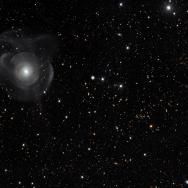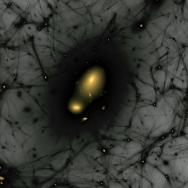Scientists may have found another way to measure the distribution of dark matter. In a surprise finding, physicists from the Dark Energy Survey announced new evidence on the link between light and dark matter.
The study focused on intracluster light, a faint type of light found inside clusters of galaxies. Scientists think this light may provide a new way to measure dark matter—a mysterious form of matter that is invisible to telescopes, yet is thought to account for the vast majority of matter in the universe. What dark matter consists of stands as one of the major mysteries of modern cosmology.
“Just measuring the intracluster light itself is pretty exciting. The dark matter part is a bonus,” said Yuanyuan Zhang, an astrophysicist with the Kavli Institute for Cosmological Physics and Fermi National Accelerator Laboratory, who led the studies.
She noted that they were able to find the correlation thanks to the enormous amount of data they had from the Fermilab-hosted Dark Energy Survey—an international effort to map the sky and understand cosmic structure. Since the observations concluded in 2019, scientists have been poring over the data it collected, looking for patterns.
This research team was initially focused on measuring intracluster light. Intracluster light has long been suspected of possibly being a significant component of clusters of galaxies, but its faintness makes it difficult to measure. No one knows how much there is or to what extent it has spread through galaxy clusters. Its source appears to be rogue stars, those not gravitationally bound to any galaxy.
Most astrophysicists measure intracluster light at the center of a galaxy cluster, where it is brightest and most abundant. “We went very far away from the centers of the galaxy clusters, where the light is really faint,” Zhang said.
The observations suggested that intracluster light reflects both the total mass of a galaxy cluster and possibly also the distribution of dark matter.
Dark matter accounts for most matter in the universe—but it’s invisible to telescopes, so scientists know only that it differs greatly from the normal matter consisting of the protons, neutrons and electrons that dominate everyday life. We only know that it’s there because of the gravitational effects it has on things we can see, like stars and galaxies.
The team used such a technique, called weak gravitational lensing, to map the distribution of a galaxy cluster’s mass—including its dark matter. Then they compared that to the radial distribution of the intracluster light, i..e, how it changes as you move away from the center of a cluster.
“Observationally we confirmed that intracluster light is a pretty good radial tracer of dark matter. That means that where intracluster light is relatively bright, the dark matter is relatively dense,” said Zhang.
“We did not expect to find such a tight connection between these radial distributions, but we did,” said scientist Hillysson Sampaio-Santos, the lead author of the new paper.
Comparing observations with simulations
To gain more insight, the team used a sophisticated computer simulation to study the relationship between intracluster light and dark matter. Curiously, they found that the radial profiles between the two phenomena in the simulation didn’t agree with the observational data. In the simulation, “the intracluster light radial profile was not the best component to trace dark matter,” said Sampaio-Santos, who is with the National Observatory in Rio de Janeiro, Brazil.
Zhang noted that it’s too soon to tell exactly what caused the conflict between observation and simulation.
“If the simulation didn’t get it right, it could mean that the simulated intracluster light is produced at a slightly different time than in observations. The simulated stars didn’t have enough time to wander around and start to trace dark matter,” she said.
Sampaio-Santos noted that further studies could yield insights into the dynamics occurring inside galaxy clusters, including interactions that gravitationally release some of their stars, allowing them to wander around.
“I’m planning to study the intracluster light and the effects of relaxation,” or spreading out, he said. For example, some clusters have merged together. These merged clusters should have different properties of intracluster light compared to clusters that are relaxed.
Enhancing signals in noisy data sets
The intracluster light that the team measured is about a hundred to a thousand times fainter than what Dark Energy Survey scientists normally attempt. That means the team had to deal with a lot of noise and contamination in the signal.
The technical aspect of the feat was challenging, Zhang said, “but because we had quite a bit of data from the Dark Energy Survey, we were able to cancel out a lot of noise to do this kind of measurement. It’s statistical averaging.”
To get the bigger picture and to beat down the noise, the Dark Energy Survey team statistically averaged about 300 galaxy clusters in the first study and more than 500 clusters in the second. All of them are a couple of billion light-years from Earth.
Teasing the signal from the noise of each cluster takes a lot of data. Luckily, that is exactly what the Dark Energy Survey collected.
The intracluster light measurements probe clusters that are up to 3.3 billion light-years from Earth. In future studies, Zhang would like to study the redshift evolution of intracluster light—how it changes with cosmic time.
“My dream is to go all the way to redshift one—10 billion light-years,” Zhang said. “Studies say that’s when the intracluster light has just started to evolve.”
Going that far would enable scientists to see intracluster light building over time.
“But that’s really hard because it’s three times as far as the distance of our latest measurements, so everything is going to be extremely faint there,” she said.
The Dark Energy Survey is a collaboration of more than 300 scientists from 25 institutions in six countries. For more information about the survey, please visit the experiment’s website.
Citation: “Is diffuse intracluster light a good tracer of the galaxy cluster matter distribution?” Sampaio-Santos et al, Monthly Notices of the Royal Astronomical Society, Nov. 26, 2020.
Funding for the Dark Energy Survey Projects: U.S. Department of Energy, the U.S. National Science Foundation, the Ministry of Science and Education of Spain, the Science and Technology Facilities Council of the United Kingdom, the Higher Education Funding Council for England, the National Center for Supercomputing Applications at the University of Illinois at Urbana-Champaign, the Kavli Institute of Cosmological Physics at the University of Chicago, Funding Authority for Studies and Projects in Brazil, Carlos Chagas Filho Foundation for Research Support of the State of Rio de Janeiro, Brazilian National Council for Scientific and Technological Development and the Ministry of Science, Technology and Innovation, the German Research Foundation and the collaborating institutions in the Dark Energy Survey.
—Adapted from an article originally published by Fermilab written by Steve Koppes.

